The Little Apple-Banana & the Magic Mangroves
With hints of an ecological message, this picture book proves it’s best to be careful what you wish for.
Yaya Heron’s The Little Apple-Banana & the Magic Mangroves is an unusual tale of a fruit who seeks help for his mother, only to narrowly escape harvesting. The story reveals the dangers of holding onto an ideal, with a dramatic battle that culminates in a life lesson.
Exiled from other trees for failing to produce more than one apple-banana, the main character’s mother is saved by a little girl, who presumably—though the scene isn’t shown—argues in favor of moving the tree from the plantation to the jungle instead of destroying it.
In the jungle, Apple-Banana wants to meet the mangrove folk in hopes that their magic will create siblings for him and allow his mother to rejoin the plantation. In time, a literal “flash of lightening [sic]” provides an epiphanic moment for Apple-Banana, who sees words “written in ice-blue letters.” He realizes the plantation is not, after all, where he and his mother belong, and that magic is sometimes mischief better left alone.
The plot may unintentionally strike an uncomfortable chord with its heavy suggestion that one-child families are necessarily sorrowful. Still, several elements hold potential. The character of the little girl, who does not reappear, may serve as a figure children could readily identify with through her belief in second chances. In revision, she might also provide a stronger focal point for the book’s underlying ecological message, which is hinted at through depictions of the banana industry as an unwelcome force in the trees’ lives. Additional refreshing aspects include the perspective that traditionally feared animals—such as a snake—can mean well.
The art cuts a few corners. Every right-hand page features the same drawing as both the cover and title page. Heavy pixilation and poor resolution that result from over-enlarging small animals also keep the work from standing out. Bolder colors, more finely detailed foliage, and greater variation in the composition would allow a setting as wild and imaginative as the mangroves to come to life. One panel does transcend the others: the lightning illuminating the flying mangrove folk perfectly evokes the text, which describes how they “whirled round and round like bobbins.”
Without dwelling on Apple-Banana’s mistake, the book provides an alternative to stories that treat magic as a ready means for solving problems. Through adversity, the determined Apple-Banana finds that his situation isn’t as bad as it seems. The indirect call for gratitude is a worthy note to end on.
Reviewed by
Karen Rigby
Disclosure: This article is not an endorsement, but a review. The publisher of this book provided free copies of the book and paid a small fee to have their book reviewed by a professional reviewer. Foreword Reviews and Clarion Reviews make no guarantee that the publisher will receive a positive review. Foreword Magazine, Inc. is disclosing this in accordance with the Federal Trade Commission’s 16 CFR, Part 255.

